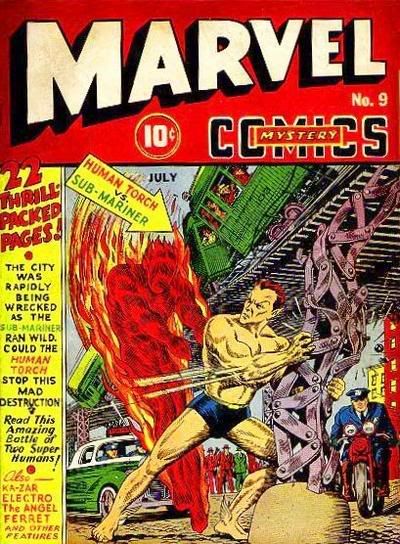
Art by Bill Everett
As mentioned in my articles The Great Marvel Mysteries, the major Marvel Comics characters Namor, the Sub-Mariner and the Human Torch, representing Hermes and Prometheus respectively, were interassociated in multiple ways since their appearance in Timely Comics' (the future Marvel) "Marvel Comics" #1 in 1939. This was the initial appearance of Carl Burgos' Human Torch. Bill Everett's Namor appeared a few months earlier in a non-Timely comics publication.
That Namor is a Hermetic figure is obvious through his winged ankles. He is also an Atlantian as well as a Mutant, a being naturally born into an evolved state in the Marvel mythos. Further evidence of Namor's Hermes resonance lies in the character's mercurial nature, he switches from Hero to Anti-Hero and back again throughout his career, starting with his initial appearances in the Golden Age. This is a display of Mercury Retrograde as discussed in my article by that name. Obviously, as a sub-aquatic character who frequently wields a trident, Namor also resonates Poseidon/Neptune. In this illustration by C.P.Smith, however, Namor's Hermetic nature is made obvious by the artist's depiction of a Caduceusial Trident:
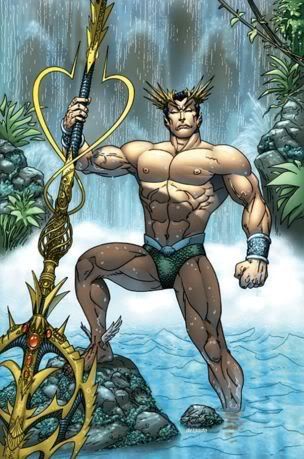
In Greek mythology the relationship between Hermes and Prometheus occurs mainly due to Hermes' role as messenger of the Olympic gods. He's the voice of Zeus. As Zeus and Prometheus are in close relation and near constant conflict, Hermes too is usually seen in opposition to the actions of Prometheus. It is worth noting, however, that Hermes and Prometheus occupy similar roles in ancient mythologies. Both characters are Illuminators and friends to humankind who bring us the arts and sciences. In certain versions Hermes is even depicted as the entity responsible for bringing fire to man. Hermes surname "Ploutodotes", Giver of Wealth, can be understood to represent the same symbolic concept.
Prometheus is one of the most intriguing figures of Greek mythology. He is a Titan, the generation of deities previous to the Olympic gods, a brother of Atlas (for whom the Atlantic and Atlantis (via King Atlas) are named, as well as bound collections of maps), Menoetius and Epimetheus (the Hind-Sight to Promethues' Fore-Sight). Prometheus comes into conflict with Zeus several times due to his role as benefactor to humankind. He tricks Zeus into accepting Ox bones as a sacrifice rather then meat, setting an unbreakable precedent. This causes Zeus to deny mankind the use of fire, but Prometheus again defies Zeus. He travels to Olympus and lights a torch off the Sun, then smuggles the ember in a hollow stalk back to mortal realm. Zeus retaliates by sending Pandora, the All-Gifted, to Earth with her box or jar of misery and evil. Prometheus is personally punished by being chained to a pillar in the Caucus mountains. Daily an eagle or vulture came and ate out Prometheus' liver, but as an immortal the organ regenerated, allowing the cycle of torture to continue endlessly. This situation persisted for many generations until, in some versions, Heracles shot the eagle and freed the Titan.
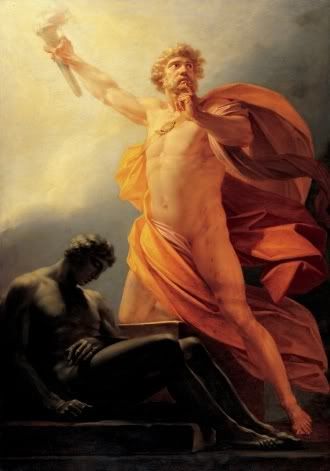
"Prometheus Brings Fire To Mankind" by Heinrich Fueger, 1817.
Initially Zeus and Prometheus are allies, Prometheus helping to secure victory for the Olymipians in the Titanomachy, the War or Clash of the Titans. In some accounts Prometheus is present at the birth of Athena (with whom he shares illuminator attributes) from the forehead of Zeus, acting as "midwife" with the use of an ax. Forethought is necessary for Wisdom to exist. Also in some accounts, Prometheus and Epimetheus help create humankind from clay.
But trouble between the two ensues when Prometheus teaches humankind the arts and sciences that make civilization possible (an act of enlightenment symbolically repeated by the gift of fire). Besides his defiance of Zeus' dictates, Prometheus, Fore-Thought, has knowledege of the events that will lead to the downfall of Zeus, a secret he is unwilling to disclose to the ruler of the gods. In Aeschylus' (perhaps) play "Prometheus Bound", Hermes, as Zeus' messenger, demands the prophecy, and when Prometheus refuses Zeus strikes him with a thunderbolt that sends him into the Abyss.
Just like Hermes, and all deities, Prometheus is a representation of a model found pan-globally in many, many seemingly diverse cultures. He is the Native American Coyote, who also stole fire from the gods as a gift to humankind and in some tales created the human race from mud, Lucifer, the Light Bringing rebel angel, the Peloponnesian hero Phoroneus, the Aztec Quetzalcoatl and Tezcatlipoca,the Vedic Agni and Yama, and the Mesopotamian Gilgamesh and Gibil.
Prometheus is also the Norse fire god Loki, in frequent conflict with thunder god Thor/Zeus, and bound and tortured till the end of time for his plot to murder the solar Balder. While Prometheus' animal torture is enacted by an eagle, Loki's is by a serpent. Interestingly both of these animals are symbols of the constellation Scorpio. Mainstream mythological study will deny this comparison, calling it a phonetic confusion with the fire giant Logi. This is not a mistake, in my opinion, but the aggregation of mythological models. Mythology does not follow the hard rules of a science. It is poetry and art. It follows dream logic. The similarities of the roles and relationships of Loki and Prometheus make their correspondence self-evident, as does Loki's name, which as the product of an Indo-European language must relate to Lux (light). Note the near exactness of the name Loki or Loke to Luci-fer. Also, like Hermes, Loki possessed a pair of winged shoes.
According to Giorgio De Santillana and Hertha Von Dechend, authors of "Hamlet's Mill", Prometheus is the equivalent of the Brahman symbol Pramantha (note the phonetic similarity), which was the male or upper stick utilized to produce fire, and symbol of the Will as the source of Activity.
"Hamlet's Mill" also contends Prometheus as being correspondent to fellow Titan, a ruler of the Golden Age, Kronos/Saturn. Prometheus in this regard may be viewed as an aspect or portion of Saturn. The authors evidence this claim by relating a Fire myth of the British Columbian Catlo'Itq tribe involving a singing stag who brings fire to all the tribes. The Stag is an emblem of both Saturn and Yama.
Suffice it to say that the story of Prometheus in all his guises is inherently related to the astronomical shifting of Great Ages. The rotating motion of the Pramantha represents the precession of the equinox brought about by the tilt of the Earth's axis, causing new pole stars to become established periodically, setting the Heavens in motion. This is associated with the castration of Uranus (ha ha) by his son Saturn/Kronos.
A few of the many modern versions of the Prometheus figure include Faust, Frankenstein and the Human Torch.
Note, the Human Torch and his variants are nearly as complex as Prometheus himself. Like ancient myths, modern comics are highly prone to reinterpretations and extrapolations, often resulting in what is called a Retcon, a "Retroactive Continuity", due largely to the employment of a "floating timeline". This makes the history of the Human Torches difficult to relate in a linear manner. To this end I relied upon the narratives presented by Wikipedia, and The Marvel Database.
The original Human Torch was created by Professor Phineas T. Horton. Horton fashioned a synthetic being that duplicated all human life functions including artificial intelligence with full emotional complexity. It was powered by "photoelectric solar cells" that covered the entire surface of the android. The power source proved volatile and exposure to oxygen caused it to burst into flames without being consumed. Horton revealed the android to the world at a press conference, keeping it in an airtight capsule, hermetically sealed.
Declared a potential danger to public safety, Horton was forced to bury his creation in an airtight tube buried under many feet of cement. Note how the Human Torch's story begins with him being buried alive, a mock death seen in many secret societies and mystery schools as an initiation process. This is the First Death of the Human Torch. A leak let in enough oxygen for the Torch to ignite, and with his flame he was able to escape easily. He quickly learned to control his flame and became a crime fighter, taking the name Jim Hammond as a civilian identity. During this era he is an ally and at other times an enemy of the Submariner.
Early in his career the Human Torch took on a ward and sidekick called Toro. Toro (the Bull or Taurus), Thomas Raymond, was the son of two scientists. His father was a fireproofing expert who worked with asbestos and his mother, Nora Jones, was a physicist working with radium. This led to the birth of a Mutant child completely immune to flames. The family came under attack from the criminal Asbestos Lady.
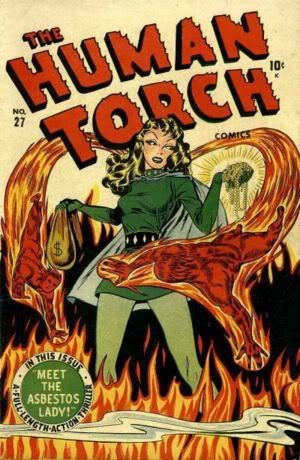
Art by Syd Shores
Toro's parents are killed in a train wreck orchestrated by the Asbestos Lady (she drops a tree on the tracks). Due to his immunity to flame Toro survives. He is found by Tom and Ellie Alexander, who happen to be circus fire-eaters. They adopt the boy and put him in their act. Note that circus means circle and can reference both the cycle of the Great Ages and the ring of the zodiac, the circle of animals. This can be seen as one of the reasons for the frequency of the circus and its performers throughout the arts. This becomes pertinent as this article progresses.
As news spreads of the circus' new fire-proof boy both the Human Torch and the Asbestos Lady set out to find him. When Toro comes into the presence of the ignited Human Torch his Mutant nature causes him to also burst into flames. The symbolic connotation of this enlightenment is obvious. Seeing that the boy possesses the same potentially dangerous powers as himself, the Human Torch adopts the child and takes him on as a sidekick.
After several years of adventures criminals ambush the duo and douse them with "Solution X-R", a chemical that paralyzes them and neutralizes their powers. While the Human Torch is in this vulnerable state the criminals bury him in the Nevada desert. This is the Second Death of the Human Torch. A few years later an atomic bomb test reactivates, resurrects, the Torch and he reteams with Toro who had retired without his mentor. Their adventures continue for a couple of years. Then the Torch realizes the atomic energy has made his power unstable. To prevent himself from causing harm to any innocents, the Torch chooses to completely burn himself out. This is the Third Death of the Human Torch, and this time it is a self-sacrifice.
Many years later, after the advent of the Silver Age, the body of the Human Torch is found by the villainous Mad Thinker, an enemy of the Fantastic Four. The Thinker revives/resurrects the android Torch and pits him against the Fantastic Four. This occurs in "Fantastic Four Annual" #4 from 1966 and involves the original Human Torch in opposition to his Silver Age antecedent. After breaking free of the Thinker's control, the original Torch intercepts a ray blast from the Thinker's creation Quasimodo, the Quasi-Motivational Destruct Organism, intended for the Fantastic Four. This is the Fourth Death of the Human Torch (in Fantastic Four Annual #4), and once again it is a self-sacrifice.
This time a funeral is held for the hero, and it is attended by Toro. Toro is kidnapped and brainwashed by the Mad Thinker, made to believe he is the Human Torch, and fitted with a collar that controls his actions.
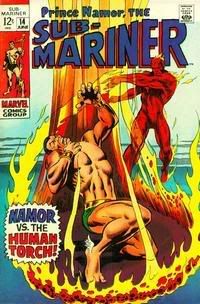
Art by Marie Severin
The collar is destroyed during a battle with Namor and the two join forces against the Thinker. Toro regains his memory. In a fit of rage he pursues the Thinker's escape rocket, causing it to crash. This is the first and only death of Toro.
In the late '80s the Torch's story is elaborated. Prior to his revival by the Mad Thinker, the time traveler Immortus created a temporal duplicate of the inert Human Torch. One was utilized by the Thinker, while the other passed into the hands of the villainous robot Ultron. Ultron transformed the Torch into the synthetic android Vision.
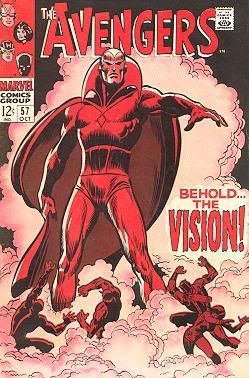
Art by John Buscema
The use of the Human Torch is a retcon of the Vision story, who originally appeared in 1968, as a Silver Age revival of Simon and Kirby's 1940 Timely character. This interestingly turns a prominent Golden Age hero into the unrelated analog of a far more obscure one. The original Vision was Aarkus, an entity with multiple origins presented in his short career. Initially he was an alien policeman from Smokeworld, described simultaneously as "thousands of miles from Earth" and as lying in an alternate dimension, who comes to Earth to fight crime. Later he is presented as the immortal first High Lama of Shangri-la.
The Silver Age Vision is another Promethean figure, himself the product of the Frankenstein resonant Ultron. He not only can control his body's density, shifting from diamond hard to vaporous, he also fires solar rays from the node over his pineal gland/third eye. Like the original Human Torch, the Vision is a fully functional synthetic being with human emotions. He falls in love with and eventually marries the Mutant Scarlet Witch, sister of the Hermetic Quicksilver. Marvel's answer to the Flash, Quicksilver is a speedster who undergoes several phase shifts from villain to hero and back again. He comes up again shortly.

Art by Alan Davis
So the one Human Torch became the Vision, while the other was utilized as a weapon against the Fantastic Four, dying during the conflict. He is revived/resurrected years later by the Scarlet Witch and joins the splinter team the West Coast Avengers.
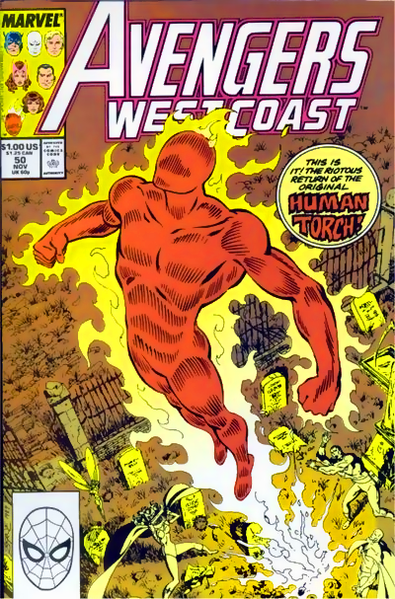
Art by John Byrne
He is forced to retire from super heroics when he sacrifices his super abilities in order to save the female Torch analog Spitfire. He goes on to become the CEO of Oracle, Inc., a corporation owned by none other then the Submariner. After that he joins the New Invaders and becomes the mentor of Tara an "Eve-Series Synthetic" based on his design. Tara is revealed to be a weapon of the Nazi the Red Skull, who was disguised as the U.S. Secretary of Defense "Dell Rusk". In order to save Tara, the Torch once again sacrifices himself, his Fifth Death.
The more familiar Human Torch, the Silver Age revival Johnny Storm has several significant symbolic details associated with him as well. When Johnny attends Metro College he rooms with the interestingly named Wyatt Wingfoot, who assists the Fantastic Four in numerous adventures.
Amongst Johnny's love interests are the Inhuman Crystal who spends some time with the Fantastic Four as a replacement for the Invisible Girl.

Art by Jack Kirby
Crystal has the power to control earth, air, fire and water. Later she's linked romantically to the aforementioned Quicksilver. They marry and have a daughter named Luna (the Inhumans live on the Moon).
Another girlfriend of Johnny Storm is Frankie Raye, the step-daughter of Phineas Horton, creator of the original Human Torch. Frankie also has flame powers and later volunteers to become a new herald for the Saturnian planet eater Galactus. Galactus transforms her into the cosmic powered Nova. She later partners and has a romantic relationship with the former herald of Galactus, the Hermetic Silver Surfer.
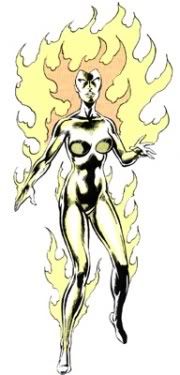
Art by John Byrne.
In more recent times Johnny Storm has also dated Namorita, the cousin (and female version) of the Submariner.

Art by Julie Bell
When the Submariner was reintroduced to Marvel Comics in the Silver Age he did so as one of the greatest villains of the Fantastic Four. He teamed several times with Dr. Doom, the two even shared a title called "Super-Villain Team-Up" in the early 70s despite the fact that by that point Namor was primarily heroic again, even serving as a member of the highly secretive team the Defenders with the Silver Surfer. As an early FF villain Namor was primarily motivated by his extreme (and rather Olympian) lust for the Invisible Girl, sister of Johnny Storm (Namor also had the hots for Quicksilver's sister the Scarlet Witch). Needless to say Johnny and Namor were seen in frequent conflict.
This interrelationship is emblemized by Alex Ross in his dystopian series "Earth X". In this story, separate from the "mainstream continuity", the Hermetic Submariner and Promethean Human Torch are combined into a single entity, Namor the Cursed.

Art by Alex Ross
The most significant interaction related to Johnny Storm and Namor occurs when the latter was reintroduced in "Fantastic Four" #4. Following a battle with the illusionist Miracle Man, Johnny has a falling out with his teammates and leaves the team. During this time he discovers an amnesiac Submariner and revives him. It is worth noting that after this encounter with Namor, Johnny quits the team for a short time, and joins his cousin Bones' circus.
"Fantastic Four" #4 was recently discussed in Robby Reed's wonderful Dial B for Blog. It was from Robby that I learned of a short lived radio program called "The Fantastic Four Radio Show", which debuted in 1975. The show presented audio presentations of mildly adapted early FF issues, amongst them the revival of Namor. Mr. Reed's powers not only include the ability to become a seemingly infinite number of super heroes, he also creates great blogs and wonderful video presentations. Here's his amalgamation of the radio program and the comic book that inspired it. Watch this video, there's a key point that comes way out from left field here:
Yes, you heard right, that's a 25 year old Bill Murray voicing Johnny Storm. The part of the Thing nearly went to John Belushi. Is it significant that actor/comedian Bill Murray played the Promethean Human Torch for a short time?